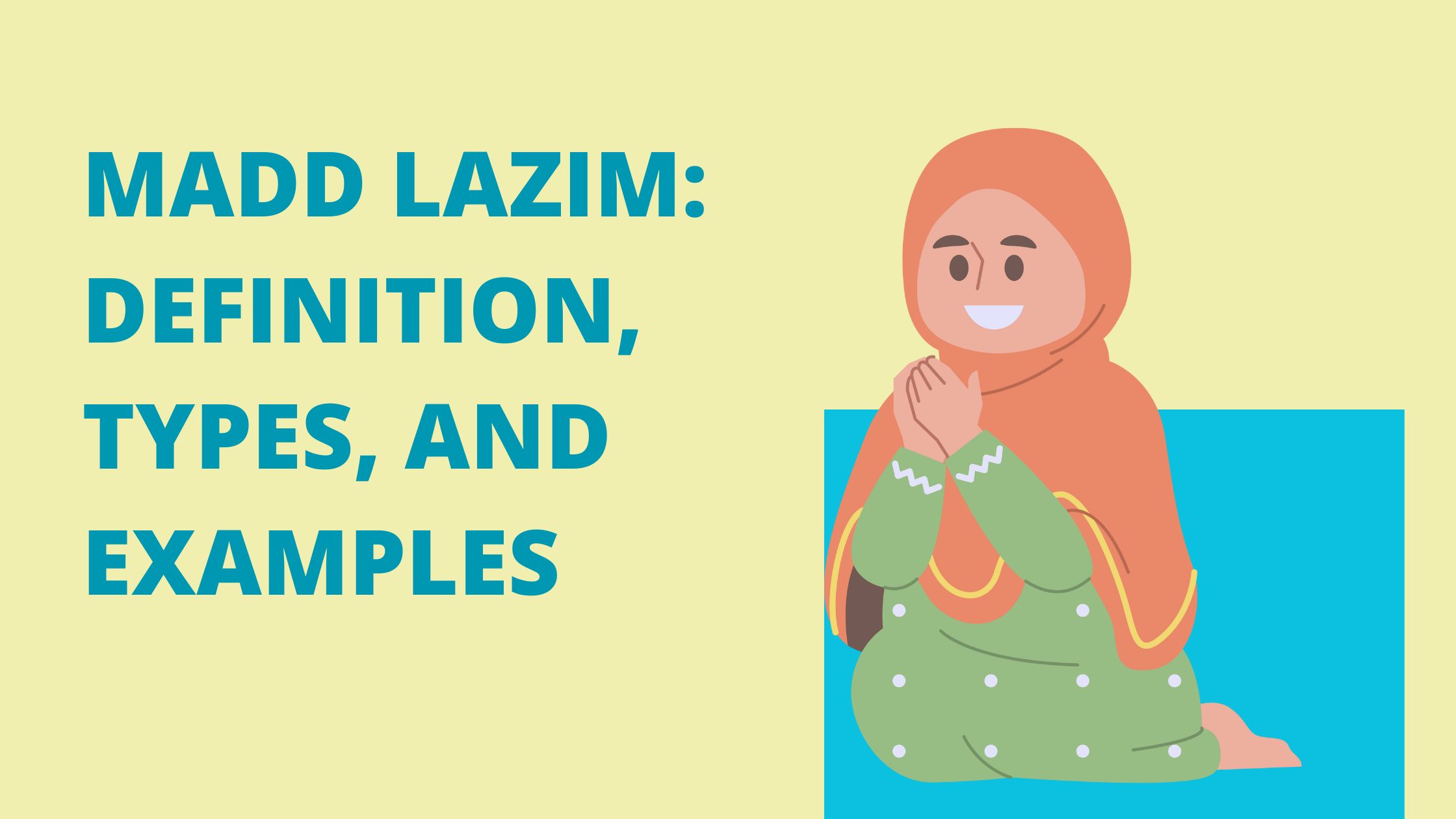In this blog post, we will delve into the importance of Madd Lazim and how it enhances our Quranic recitation.
Whether you are a beginner or an experienced student, understanding this concept will undoubtedly elevate your relationship with the divine words that guide you on your path.
Madd Lazim is a crucial aspect of Tajweed that may seem complex, but its significance cannot be overstated. So, let’s dive in and explore the fascinating world of Madd Lazim!
Table of Contents
Definition of Madd Lazim
Madd Lazim is an essential concept in Tajweed and Quranic recitation. It refers to the prolongation of certain letters or sounds within a word, which adds beauty and emphasis to the recitation.
The term “Madd” originated from Arabic and means elongation or stretching, while “Lazim” indicates something compulsory or necessary.
Together, Madd Lazim refers to the necessary elongation of specific letters within certain words during recitation.
Madd Lazim occurs when an obligatory Sukoon (a non-vocalized state) follows a letter of prolongation within a single word.
Significance of Madd Lazim
Madd Lazim plays a pivotal role in Quranic recitation by enhancing its beauty and rhythmic flow while connecting readers with the divine message, offering a deeper understanding of sacred words and serving as a guidepost for accurate interpretation.
1. Enhancing Beauty and Rhythmic Flow
The significance of Madd Lazim lies in its ability to enhance the beauty and rhythmic flow of Quranic recitation.
By elongating certain letters, we add depth and melodiousness to our recitation, captivating both the listener and ourselves as readers.
This rhythmic pattern highlights the aesthetic aspect and amplifies the intended impact and meaning behind each word.
2. Connecting with Divine Message
Mastering Madd Lazim allows us to connect with Allah’s divine message on a deeper level. It enables us to better understand and convey His sacred words as they were revealed.
Through this mastery, we can fully appreciate the intricacies of linguistic nuances embedded within each verse while maintaining reverence for their spiritual essence.
3. Aesthetic Appeal and Spiritual Significance
Apart from its aesthetic appeal and spiritual significance, understanding and correctly applying Madd Lazim are crucial for accurately interpreting verses in various contexts.
The elongation serves as a guidepost for correct pronunciation, highlighting specific elements that carry grammatical distinctions or subtle shifts in meaning within sentences.
4. Better Understanding of Tajweed:
Studying Madd Lazim in the Quran allows for a better understanding of Tajweed’s rules, emphasizing the significance of correct pronunciation and showcasing the meticulous preservation of the Quran. It leads to a deeper appreciation of the recitation’s beauty and perfection.
Types of Madd Lazim
Madd Lazim is considered the longest type of Madd. It can be classified into two main types:
1. Kalimi (word-based)
2. Harfee (letter-based)
These two types further branch out into:
1. Muthaqal (heavy)
2. Mukhaffaf (light)
Resulting in a total of six types of necessary prolongation. Let us embark on a captivating journey to explore each type in greater detail.
1. Madd Lazim Kalimi
Madd Lazim Kalimi can be further divided into two mesmerizing subtypes:
First Type:
Madd Lazim Kalimi Muthaqal, the realm of heavy word-based necessary prolongation
Second Type
Madd Lazim Kalimi Mukhaffaf, the domain of light word-based necessary prolongation.
The purpose of Madd Lazim Kalimi’s rules
The rules for necessary prolongation in Arabic are meant to prevent two consecutive Saakin letters from being pronounced to maintain smooth pronunciation.
Hence, a “madd” is gracefully inserted between the two Saakins, preserving the elegance of pronunciation.
A. Madd Lazim Kalimi Muthaqal
We encounter words that possess a majestic “lazim” Saakin letter. This regal letter, adorned with a Sukoon as part of the original structure of the word, harmoniously follows a Harf Madd.
This Sukoon manifests itself due to the presence of a Shaddah, which blesses the letter with a doubling effect. The first occurrence boasts a Sukoon, while the second occurrence bears a diacritic.
B. Madd Lazim Kalimi Mukhaffaf
Madd Lazim Kalimi Mukhaffaf unveils its enchantment when a Harf Madd intertwines with a noble “lazim” Saakin letter.
The Sukoon remains unmerged with another letter. Should a Shaddah appear and bestow its doubling magic upon a letter, the first occurrence elegantly merges with the second, producing a resplendent unity known as a Mushaddad letter.
However, bear in mind that this type of necessary prolongation does not arise from the touch of a Shaddah, but rather from a Sukoon that emanates from the word’s inherent structure. The duration of this melodious necessary prolongation resonates for six illustrious counts.
2. Madd Lazim Harfee
The second branch of Madd Lazim is Madd Lazim Harfee, also recognized as letter-based necessary prolongation.
In this captivating exploration, we shall delve into:
1. Madd Lazim Harfee Mukhaffaf, the embodiment of gentle letter-based necessary prolongation.
2. Madd Lazim Harfee Muthaqal, the realm of weighty letter-based necessary prolongation
It is crucial to acknowledge that both types of Madd Lazim Harfee find their home solely within those surahs of the Quran commencing with letters. Such chapters include Surat Al-Baqarah, Surat Maryam, and Surat Qaaf.
A. Madd Lazim Harfee Muthaqal
Madd Lazim Harfee Muthaqal is a beautiful occurrence found in sacred scripture, where a letter at the beginning of a surah emits three melodious sounds and merges smoothly with the following letter.
Surat Al-Baqarah’s opening contains the letters alif, laam, and meem with a focus on the graceful transition of the letter laam into a melodious Harf Madd “aa” sound. The “mm” sound of meem connects smoothly with the next verse.
B. Madd Lazim Harfee Mukhaffaf
Madd Lazim Harfee Mukhaffaf is a concept in Arabic language and phonetics. It explains that each letter in this context is extended for a count of six unless a unique exception occurs. These letters have three distinct sounds, with the Harf Madd being the prominent one, while the final note remains silent without vocalization.
The letter “qaaf” (ق) is given as an example, highlighting its poetic resonance. The progression of the sound is described, starting with a strong “Q” sound, followed by the graceful Harf Madd “aa” represented by alif, and ending with a serene silent sound.
The reader is encouraged to appreciate the celestial harmony created by these letters and their symphony that resonates deeply. The phrase “naqasa ‘asalukum” is mentioned to remember their captivating beauty.
Three Exceptions of Madd Lazim
The rules of Madd Lazim govern the lengthening of specific letters, lending a distinct rhythm and melody to the sacred verses. Yet amid this melodic tapestry, exceptions emerge, each with its own unique charm and intrigue. Let’s explore:
1. The Ethereal Letter “Alif” (ا)
The first exception resides in the ethereal letter “alif” (ا), which refuses to conform to the prolonged fate of its counterparts.
It boldly stands as “alif,” unyielding to elongation. Yet fear not, for its distinct pronunciation still carries a mystique of its own.
2. Defying Expectations: (hayy tuhr)
Next, we encounter a group of letters that chose a path less traveled. “Raa,” “haa,” “taa,” “yaa,” and “haa” (ح, ي, ط, هـ, ر) dare to merge their sounds with the realm of madd for merely two counts, defying expectations with grace.
Remember them well, for they form a harmonious melody known as the phrase “hayy tuhr.
3. Distortion of Familiar Forms
The letters “raa,” “haa,” “taa,” “yaa,” and “haa” (ح, ي, ط, هـ, ر) shed their alphabetical pronunciations, unveiling a new identity. No longer shall “yaa'” (ياء) echo through the air; instead, only the graceful “yaa” (يا) shall emerge. This peculiarity extends its enchanting spell to all five letters.
4. The Elusive Letter ‘Ayn’ (ع)
The letter ‘ayn’ (ع) is a subject of great intrigue among scholars. Its elongation knows no bounds, capable of extending its reign over time for 2, 4, or 6 counts.
Though the preferred length is 4 counts, the wisdom behind this exception remains shrouded in mystery, a captivating enigma worth exploring.
Examples of Madd Lazim in the Quran
The rules of Madd Lazim within the Quran offer a rhythmic and melodious dimension to the sacred text. Four specific examples shed light on this phonetic art:
1. Madd Lazim Kalimi Muthaqal:
One such example is “الطآمَّة”. Here, the madd letter is accompanied by a letter bearing a shaddah.
The prescribed measure for this madd is 6 counts, emphasizing the prolonged pronunciation of the word.
2. Madd Lazim Kalimi Mukhaffaf
An illustration of this can be seen in the word (ءَآلْئَٰن). When applying the rule of Madd Lazim Kalimi Mukhaffaf, the count for the elongation is six counts.
When pronouncing certain letters, it is important to maintain their sounds even when followed by a sakin letter (with a sukoon).
3. Madd Lazim Harfee Muthaqal
The sequence of letters (طسٓمٓ) in the Quran involves a severed letter (س) with a madd sandwiched in between (م).
When reciting, these letters are pronounced as “ta – seen – meem” and must be considered concerning the following letter for proper pronunciation.
If a letter causes Idgham, it becomes Mushadad, meaning it is pronounced heavily.
4. Madd Lazim Harfee Mukhaffaf
The Quran contains the letter sequence نونْ, which is pronounced as نٓ and represents a madd letter followed by a sakin letter. This causes the initial letter to have a ‘light’ pronunciation.
Resources for learning and improving Madd lazim’s skills in Tajweed
If you are interested in deepening your understanding of Madd Lazim and enhancing your Quranic recitation, there are several resources and courses at BayanalQuran available to help you. These resources provide comprehensive lessons and interactive exercises that will enable you to master the correct application of Madd Lazim:
1. Online Courses:
Many online platforms like BayanalQuran offer structured courses on Tajweed, including specific modules dedicated to Madd Lazim.
These courses typically include video tutorials, audio recordings, quizzes, and practice exercises to help students grasp the concepts effectively.
2. Tajweed Books:
There are numerous books written by renowned scholars that focus on the rules of Tajweed, including detailed explanations of Madd Lazim.
These books often come with accompanying CDs or MP3 files for pronunciation guidance.
3. Mobile Applications:
With advancements in technology, there are now mobile applications specifically designed to assist individuals in learning tajweed principles at their own pace. These apps allow users to listen to expert reciters while following along with highlighted text for better understanding.
4. Online Tutoring:
If you would like individualized attention and feedback on your tajweed skills, we recommend enrolling in online tutoring sessions with qualified instructors at BayanalQuran.
Our instructors specialize in teaching Quranic recitation, with a focus on accurately applying rules such as Madd Lazim.
By studying with mentors and practicing consistently, you can improve your tajweed skills and specifically focus on Madd Lazim for better Quranic recitation.
Benefits of Madd Lazim in Quranic recitation
Madd Lazim, a fundamental element of Tajweed, offers numerous advantages in the art of Quranic recitation:
1. Enhancing the Recitation
– Madd Lazim enhances the beauty and melodiousness of the recitation
– Madd Lazim adds rhythm and flow to the recitation, making it more captivating for listeners
2. Improving Pronunciation and Clarity
– Madd Lazim helps to maintain correct pronunciation and clarity in the recitation
3. Enhancing Understanding
– Madd Lazim increases understanding of the meaning behind the verses by emphasizing important words or phrases
4. Deepening Spiritual Connection
– Madd Lazim deepens spiritual connection with the Quran through a more accurate and precise recitation
5. Boosting Confidence
– Madd Lazim builds confidence in individuals who are learning or practicing Tajweed, as they master this essential aspect of proper Quranic recitation.
Unlock the Beauty of Quranic Recitation: Join BayanalQuran’s Online Tajweed Classes Today!
At BayanalQuran, we offer comprehensive online Tajweed classes that focus on developing your skills in Madd Lazim and other aspects of proper Quranic recitation.
Our experienced instructors will guide you through step-by-step lessons, providing valuable feedback and support along the way.
Don’t miss out on this opportunity to unlock the true beauty of Quranic recitation – enroll in our online Tajweed classes at BayanalQuran today!
FAQs
How many types of Madd Lazim are there?
There are two main types of Madd Lazim – Kalimi and Harfee. Each type has its own rules and variations.
Why is the proper application of Madd Lazim important?
Proper application of Madd Lazim enhances clarity and beauty in Quranic recitation. It helps convey meaning accurately and allows for better understanding by listeners.
How can I learn and improve my knowledge of Madd Lazim?
There are various resources available for learning Tajweed and improving your understanding of Madd Lazim. Online platforms like BayanalQuran offer comprehensive courses taught by experienced teachers who guide students through theoretical concepts and practical applications.
Conclusion
The proper understanding and application of Madd Lazim in Tajweed and Quranic recitation are essential for every student of the Quran.
By mastering the different types of Madd Lazim, such as Kalimi and Harfee, learners can unlock the beauty and eloquence of the Quran in their recitation.
The correct pronunciation and elongation of vowels through Madd Lazim enhance clarity, rhythm, and melody in recitation.
Through resources like BayanalQuran’s online Tajweed classes, students can deepen their knowledge and skills in Madd Lazim while receiving guidance from experienced teachers.
So, join us today to embark on a transformative journey toward perfecting your recitation of Allah’s noble words!















